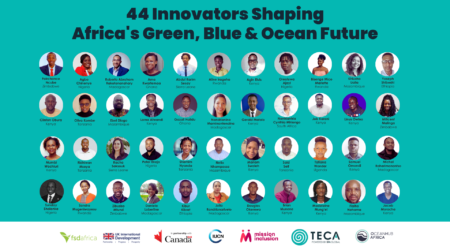4 Innovation Opportunities to Unlock the Potential of Blue Carbon
The blue carbon wave
This week at COP27 in Sharm El Sheikh, Egypt, global thought leaders will come together to negotiate around how to decarbonize our planet while adapting to a rapidly changing climate. Today, they discuss water, including impacts and opportunities for coastal protection. Blue carbon will surely be a topic of conversation, as it has rapidly emerged as a viable solution for resilient coastal livelihoods.
Blue carbon is the carbon that is stored in coastal and marine ecosystems, including mangroves, tidal marshes, seaweed beds and the ocean floor. Projects that restore or protect these ecosystems are able to generate “credits” based on the quantity of carbon captured and/or stored. These can be sold and traded within the Voluntary Carbon Market (VCM).
The Voluntary Carbon Market allows carbon emitters, from private corporations to individuals, to offset emissions via purchasing carbon credits generated by projects that sequester or avoid emissions of carbon. For example, restoring mangroves sequesters carbon from the atmosphere to be stored in the biomass of the tree and within the soil. After the validation of this sequestration, a carbon credit can be traded on the market.
While the greenhouse gas mitigation benefits are obvious, projects that can plug into the VCM also generate co-benefits related to income generation, livelihood improvement and resilience to climate impacts. For example, new mangroves can provide additional income and livelihood improvement via honey production and can provide climate resilience by acting as a buffer against coastal storms. These types of co-benefits may be of even greater value than the income generated from the sale of a carbon credit, especially in emerging markets that are extremely vulnerable to climate change.
Catapulting the blue carbon market
The voluntary carbon market is currently valued at over US$ 2 billion and is expected to reach up to US$50bn by 2030. While it is unclear exactly how much blue carbon will make up this market, this segment of the VCM is swelling and the potential is huge. A 2019 High-Level Panel for Sustainable Ocean Economy report stated that blue carbon ecosystems could help reduce as much as 1.4 billion tons of CO2-equivalent emissions annually – a major contribution to reaching Net Zero.
Emily Landis from The Nature Conservancy says that blue carbon is still 10 years behind the forest carbon market (e.g., restoration of tropical forests or sustainable agriculture practices), but we are quickly closing that gap with science and innovation. The question is, how do we leapfrog the developments in the forest carbon market to bring the blue carbon market to its full potential as soon as possible? And, importantly, how do we make that market work for smaller land stewards and marginalized communities?
A large part of the answer is investing in novel climate fintech solutions across the blue carbon market value chain. Initiatives like the Triggering Exponential Climate Action (TECA) program can help to launch new fintech ventures that develop the solutions that the blue carbon market needs to realize its potential and serve marginalized communities. Four TECA fellows highlight innovation areas that could catapult blue carbon 10 years forward:
1. Local marketplaces
The voluntary carbon market is currently a fragmented space, with many different types of accreditation standards, unclear real prices and limited access by vulnerable communities. This makes it very difficult for blue carbon project suppliers to enter the market, even if they have substantial resources. At the same time, buyers struggle to really know what they are buying – whether it is high quality or laden with risk. One of the reasons for this is that there are currently limited local marketplaces that provide reliable, direct purchases.
For example, directly connecting coastal tourist activities to carbon markets may allow buyers to better understand how they are offsetting their carbon emissions while providing additional income to the communities they are visiting. TECA fellow Amir Gerges says,
When it comes to offsetting eco-tourism activities it’s critical to leverage the power of a once in a lifetime opportunity, where people experience nature as it truly is, and not through the screen of a mobile phone and filter. Nudging at the right moment can make all the difference, converting a traditional tourist to an environmental advocate…”
2. Affordable, intuitive verification
Monitoring, reporting and verification (MRV) is an essential step in creating a quality carbon credit. However, due to high MRV costs, only projects that are larger than 10,000 hectares are financially viable. Approximately 60-90% of a carbon credit price gets sucked up by intermediaries like those that provide third-party validation. That means that only a small fraction reaches the vulnerable community members that supplied the credit, and need the additional income the most.
Currently, blue carbon suppliers, like those restoring mangroves or seagrass beds, have limited capacity to implement their own monitoring and verification, largely because they lack access to the skills and equipment needed to measure carbon in these complex ecosystems. According to TECA fellow Sheila Ruto,
Local communities could save a lot of time and money by performing their own MRV. Utilizing innovative digital technology that simultaneously builds local capacity for monitoring and provides credible verification may be the solution for communities like those restoring mangroves in Kenya. Importantly, we also need to consider MRV for non-carbon related activities as part of these projects, like water purification, inorganic waste reduction or flood mitigation.”
3. Embedded carbon tech
While prices for blue carbon are expected to increase, the average price of blue carbon credits is currently too low to incentivize smaller project suppliers. One workaround is to embed carbon into other products that would help to subsidize the costs for project implementation. For example, this could be integrating blue carbon into coastal insurance products to lower monthly payments or leveraging blue carbon to subsidize agri-inputs for aquaculture.
A rapidly growing area of blue carbon is found in seaweed farming. Seaweed farming has vast potential for carbon sequestration in the blue economy, yet implementation costs remain high. “What we really need is to lower the barriers to entering this industry,” TECA Fellow Anga Mbeyiya claims.
Integrating blue carbon credits into seaweed offtake marketplaces or input supply apps may provide these producers with the subsidies they need to get beyond upfront costs and build sustainable business models.”
While seaweed is already popular in Asia, Africa’s coastal communities are poised to scale planet-positive seaweed farming. Seaweed that is found in fertilizers, food, and cosmetics can play critical roles in sustainable value chains. With the right embedded carbon tech, seaweed can be a powerful solution for both mitigation and adaptation.
4. Solutions on chain
As the voluntary carbon market expands and matures, innovators are interested in leveraging blockchain technology to help solve problems regarding transparency and the costs of transactions. This in turn would build security and confidence in the market, helping it to scale. While blockchain has been a hot buzzword in the market, it’s still unclear where the best entry points are.
“Tokenizing natural assets within the blue carbon market that are related to co-benefits may be one of the best applications of blockchain in the VCM,” attests TECA fellow Samke Mnguni.
There is still a struggle to evaluate, quantify and sell blue carbon project co-benefits, like those related to biodiversity or community well-being. Blockchain could help provide a more efficient and transparent solution that benefits both buyers and suppliers.”
Boost innovation finance post-COP27
While it’s clear that investment in innovation in the blue carbon market is needed, ventures in nature-based solutions like blue carbon projects, receive the least amount of investment. This needs to change.
Initiatives like the Climate Innovations for Adaptation and Resilience (CIFAR) Alliance are making the case for mobilizing catalytic capital for blue carbon solutions and helping to build local blue innovation ecosystems in emerging markets. Under CIFAR, the Carbon Finance Working Group recently published a brief outlining a path to resilient livelihoods in the voluntary carbon market. This document echoes and elaborates on the key opportunities TECA fellows are trying to unlock.
In the wake of COP27, TECA entrepreneurs hope that investors will listen to the calls for action brought by attending CIFAR members. Investing in innovation in blue carbon will be critical for a climate-resilient future.
TECA’s mission is to launch 100 ventures by 2026 to bolster the climate resilience of vulnerable communities and the planet, leveraging fintech and other enabling technologies.

![[Press Release] 7 African Startups to Receive $385k to Develop Solutions for the Blue Economy](https://bfaglobal.com/wp-content/uploads/2023/02/Wave-1-startup-announcement--450x250.png)

